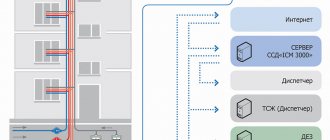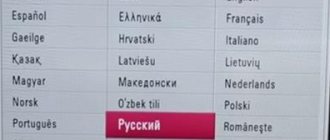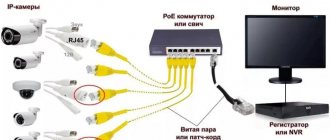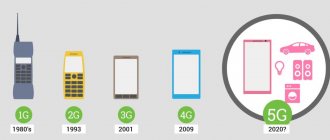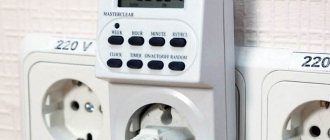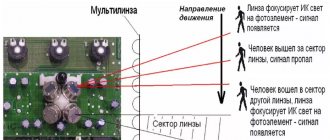The more consumers there are at a facility, the higher the uncontrolled energy consumption. In large enterprises, where consumption is measured in tens or hundreds of thousands of kilowatts, this is a huge overhead expense. Every prudent owner wants the cost of organizing to be as small as possible. This is especially important for production: reducing the cost of manufactured products provides undeniable competitive advantages in the market.
Initially, this was done by special units for accounting and monitoring energy consumption. Previously, before the introduction of automation, the chief power engineer’s service employed dozens of employees with high salaries. But the human factor did not provide the opportunity for effective savings.
A couple of decades ago, engineers and scientists introduced the ASKUE system (automated system for commercial electricity metering). The technology involved the use of microprocessor control, which was quite expensive at that time. Of course, if we were talking about millions of dollars in energy costs, the funds invested in installing ASKUE paid for themselves quickly.
Application of ASKUE
An information processing center (IPC) is installed in the control room; a separate room is not necessary; data on current energy consumption from each group of consumers flows into it.
Over time, an automated metering system began to be implemented at facilities with lower power consumption: for example, in residential neighborhoods. Serial production reduces prices, and the introduction of ASKUE has become possible even at the level of small housing cooperatives. In this case, the information processing center can be located both in the control room of the energy supply company and in the office of the board of housing cooperatives.
Modern technologies make it possible to organize a data exchange network not only through specially equipped networks. Your own wiring is quite expensive: the cost of the cable, labor costs for installers, rental of load-bearing supports, project approval. With the advent of publicly accessible means of communication, it has become possible to reduce the costs of operating automation of accounting systems. Wireless communications, cloud networks, free access to the Internet allow you to control energy consumption on mobile devices and computers, which there is no need to buy specifically for ASKUE.
Any user, or designated operator, controls the equipment of an individual or public ASKUE from a virtual workplace, or even from a smartphone. The main costs come down to the purchase of subscriber control devices and software. Today, Smart Home technology is being actively implemented, within which it is possible to set up electricity metering in small rooms. The owner of a home or office can automate energy consumption while being at any distance from the control object.
We’ve sorted out accessibility and convenience, let’s look at the operating principle of ASKUE.
Who benefits from implementation?
As you know, maintenance and installation of ASKUE are not easy tasks, both in material and practical terms. Who benefits from installing and implementing the system today? It would be advisable to note that starting from 2012, an increasing number of consumers are moving from providing electricity metering in the traditional way (subject to the use of visual monthly readings of metering mechanisms) to the introduction and installation of an automatic machine. By the way, the AIIS KUE system is currently also relevant.
It is important to note that gardening partnerships, industrial structures and legal entities usually decide to establish ASKUE. In addition, HOAs and multi-apartment residential premises often resort to its use. How useful will the installation of an automated system be for the consumer and what does it allow you to accomplish? It would be advisable to understand these issues in more detail.
How it works
Let's start with the tasks performed by an automated system for monitoring and accounting for energy consumption:
- Collection of data from each individual consumer (group of consumers) about the consumption of electrical energy at the current time and for a certain period.
- Transfer of data from monitoring devices to a unified information processing center (IPC). Information channels cannot be intercepted or bypassed, since communication through them is encrypted.
- Processing the received information, systematizing it, obtaining summary reports and a current picture of energy consumption in real time. Performed using computer technology.
That is, ASKUE allows you to collect information about energy consumption from an object (group of objects) with a high degree of reliability. At the same time, possible errors and deliberate distortion of information are minimized, which is often encountered during manual data collection (the notorious human factor is eliminated). This helps prevent unauthorized connection and illegal extraction of electricity. Therefore, large energy operators welcome the introduction of such technologies.
In addition, installation of ASKUE throughout the entire chain from the power plant to the end consumer ultimately provides significant savings in energy resources. Not to mention the reduction in costs of energy supply companies that arise when the transferred capacities do not correspond to the readings of the consumer’s internal metering devices.
Problems solved by the producer and consumer of electricity
- Energy supply companies do not spend much time or money identifying unauthorized electricity withdrawals. In addition, by systematizing data on consumption levels, unified energy systems of regions and the entire country can timely distribute power to eliminate critical points of excess load.
- The consumer controls his expenses, thereby saving money. Automated accounting allows you to credit money without the need to take readings from electricity meters, calculate the cost of tariffs, or manually pay bills. It is enough to install software on the organization’s computers to account for and generate payments for electricity.
- In addition, working with automated control allows you to analyze cost parameters and select prices for consumed electricity with different tariffs: including differentiation by time of day.
Description and purpose of ASKUE
The abbreviation ASKUE stands for the following:
- A – automated;
- S – system;
- K – commercial;
- U – accounting;
- E – electricity.
Sometimes the decoding is supplemented by a clarification - an information measuring device.
Traditionally, meter readings are taken by apartment owners themselves or by employees of energy supply companies. More precisely, both do this: the first to pay for electricity supplies, the second to control. However, the action is performed manually, which is inconvenient.
The automated system allows you to take meter readings immediately from each apartment and transfer them to the company . In this case, the data is encrypted, which reduces transmission time and ensures security.
Automated accounting is much more effective in places where it is necessary to take readings from points remote from each other that make up one system. ASKUE serves homes, ports, train stations, airports, and transshipment terminals.
Functions
In addition, the device has additional intelligent functions: it can predict electricity consumption, calculate cost indicators, etc. The main tasks of ASKUE include the following.
- Collection of information on electricity consumption by each consumer. In this case, the consumer is the owner of the apartment and the complex of equipment in his possession, and not the electrical device itself.
- Transfer of collected data via an encrypted communication channel to the processing center.
- Performing operational calculations of electricity consumption at established tariffs.
- Live balance tracking.
- Consumption forecasting , which allows you to prepare the network for loads.
ASKUE provides information about the status and operation of the entire controlled network. This allows you to quickly solve current problems: change the consumption mode, detect problems on the line, track power leaks, etc.
Principle of operation
Electronic meters record information, each on its own branch, and simultaneously send a signal. The frequency of messages is regulated by the AS.
Information is archived in adders. From here the data goes to the server. If the AC is small, the data can be directly transmitted to the collection server.
Data processing
Technical energy metering and control devices also work according to this scheme. The difference between them and commercial ones is their purpose. This is discovered at the last stage: ASKUE uses the received data for other purposes.
The features are as follows:
- The data that is transmitted to the processing center is necessary for generating bills for consumers and is internal information of the energy company.
- An algorithm for performing this exact task.
- According to the law, every consumer must have energy metering devices, which allows them to get a complete picture. The technical system solves only internal problems.
The ASKUE is designed taking into account the characteristics of a specific object: an apartment building, a garage cooperative, a holiday village.
Scope of application
The device can be installed on any complex facility where there are many energy consumers and meters. It is used in both industrial and residential buildings:
- apartment buildings;
- office and administrative buildings;
- dacha or cottage village;
- network of garages;
- transport and industrial enterprises;
- ports, railways, airports;
- terminals of different power.
ASKUE eliminates input errors when collecting registration data. This is especially important if the network includes consumers of different powers.
Technical support for automated commercial electricity metering systems
- Installation of modern electronic electricity metering devices at all group consumption points, with the ability to remotely read parameters in real time (computer or specialized network).
- Development and connection to metering devices of special adder modules with internal memory, which will accumulate data and separate them according to tariff classification. These modules must be provided with autonomous (backup) power.
- Laying wired communication lines between metering devices, data storage devices and information processing centers. Data exchange can be organized using wireless networks or using the Internet. Communication lines must provide for sending reports in real time to the consumer's subscriber device to ensure control over the formation of summary data. Channels are protected from unauthorized connection (encoding). First of all, this is done to protect against hacking and the provision of distorted information.
- Arrangement of information processing centers (IPC), equipped with high-speed computing systems (servers). It is also necessary to provide for the possibility of connecting remote access systems to the COI, so as not to tie operators to a physical workplace.
- Equipping servers and computerized workstations with specialized software. When using remote access, it is necessary to install programs running under mobile operating systems.
- Ideally, the energy sales company should have access to the information. For efficient operation of automation, autonomous equipment is also installed at transformer substations.
Subscriber software and hardware
An electronic active energy meter (single-phase or three-phase, see Fig. 2) performs the following functions:
— measurement and accounting of consumed active electricity and power;
— calculation of unpaid electricity (calculation of debt);
— warning the subscriber about exceeding the payment debt, limiting the power consumed by the load or disconnecting the load;
— measuring the current value of the network voltage, recording facts of exceeding its standard limits and protecting the subscriber’s electrical equipment by disconnecting it (set at the stage of setting up the meters);
— maintaining a calendar and real-time clock, multi-tariff electricity metering;
— receiving and executing control commands;
— turning on/off the load or limiting power consumption at the command of the energy sales manager;
— maintaining a log of electrical network events and a log of received commands;
— indication of the status and operating modes of the meter, network and load parameters;
— transfer of the contents of the non-volatile memory of the meter to the controller device via radio or infrared communication channel, KB-485 interface;
- other functions.
Rice. 2. Electronic multifunctional meter
Rice. 3. Subscriber kit mounted on the OIC rail
The RCD (relay) acts as a switching element in the load circuit.
It is controlled by an electricity meter and installed together with it in the panel on the OSH rail (see Fig. 3).
ASKUE has two versions of electricity meters: for individual buildings and for multi-apartment residential buildings.
The modifications differ in that the meter for an apartment building does not contain radio modules, which are included in the meter for individual buildings. The meter of an apartment building is controlled via the KB-485 interface from a master unit additionally installed on a group of meters (up to 255 pcs.). The latter has the ability to receive information from energy sales both via a radio channel and through KB-485 from a mobile controller console or laptop computer.
System separation
For uninterrupted operation and increased reliability “to failure”, the automated system for commercial electricity metering is carried out according to a multi-level principle.
- The first level is a system of subscriber metering devices. In branched networks, this level also includes data storage devices. In addition, you can use various sensors that analyze the actual energy demand at a specific facility. For example, light or temperature sensors.
- The second level is a system for transmitting data and converting information into a format with which the information processing center software works. In some projects, data storage devices belong to the second level if they are integrated into signal conversion systems. Communication lines can be classified as the second level of the system, or separated into a separate structure. For ease of maintenance, they are usually tied to level 2.
- The third level is information processing centers: management servers and storage of finished converted data. As a rule, automated operator workstations are equipped at the COI locations (if a serviced ASKUE is used). The hardware is installed taking into account information protection and system redundancy. If the control center is responsible for managing the power system (distribution and transformer substations), an unexpected shutdown of the system can lead to a large-scale breakdown of the power system.
Installation of ASKUE system
All installation, connection, and adjustment of automated commercial electricity metering systems are performed by certified contractors. The contractor, upon completion of the work, must coordinate and organize the connection of the complex to the management of energy systems on the territory.
Installation sequence:
- Study of the site, selection of equipment in agreement with the customer, preparation of design and estimate documentation. The customer is obliged to provide the contractor with all the documentation used to supply energy to the facility.
- Preliminary approval of the project with energy sales authorities.
- Carrying out commissioning work, determining the period of test operation, putting the system into permanent operation mode.
- System support after installation and launch.
- Setting up software, connecting remote workstations.
When setting up the system, performance tests (recovery) in emergency situations and checking protection against hacking of information are required.
The Contractor is responsible for warranty service and for the safety of ASKUE within the territorial energy supply system.
Let's find out!
How exactly does the introduction of an automated system help to significantly reduce the cost of electrical energy? Everyone knows that its calculation is different for business and enterprise and for society (individuals). Thus, the procedure for calculating electricity tariffs for the population is somewhat different from energy tariffs for legal entities. Nevertheless, for both the former and the latter, the installation and further maintenance of ASKUE will contribute to a significant reduction in prices. All kinds of structures and businesses have the opportunity to choose different price categories for electrical energy for calculations. It is important to note that determining the optimal category in terms of prices, as a rule, allows you to reduce the cost of electrical energy by up to thirty percent. However, for calculations in accordance with 3, 4, 5 or 6 price categories, you need to take hourly meter readings every month.
Naturally, ASKUE may not be implemented. However, no one will argue that taking readings from metering devices on a monthly basis is not entirely convenient. That is why, after the formation of the system under consideration, a business representative one way or another gets the opportunity to manage the cost of electrical energy, as well as choose the most optimal payment method. If we consider large consumers who are planning to enter the wholesale electricity market, it is definitely impossible to do without installing an AIMS KUE. Therefore, when an enterprise is guaranteed to be interested in switching to direct payments with electricity suppliers and saving on the services of various “intermediaries,” the AIIS system is nothing more than a mandatory condition.
Equipment for automated commercial electricity metering systems
Data transmission systems, information format converters, data storage devices are special devices. The customer chooses the brand, configuration, and composition of the equipment. Subscriber devices are standard certified metering devices, with the ability to connect to information reading devices.
Without connection to the system, these meters operate as usual.
Moreover, for the operation of ASKUE it is not necessary to use electronic metering devices. There are also mechanical models with the ability to select data.
Workplaces and server equipment are organized on the basis of personal computers. Typically running Windows OS. After installing specialized software, the computer becomes part of the ASKUE.
Bottom line
Power engineers believe that soon all energy supply systems will be integrated into ASKUE. There are more and more electronic devices, electricity is a renewable energy. Those organizations that are already connected to the automated commercial electricity metering system will work as usual. The rest will still have to purchase equipment and order installation. Experts have calculated that the introduction of a global automation system will reduce energy consumption nationwide by up to 40%.
